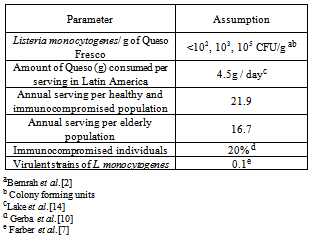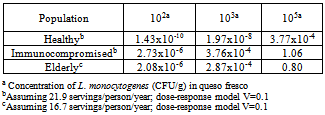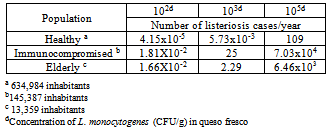-
Paper Information
- Next Paper
- Previous Paper
- Paper Submission
-
Journal Information
- About This Journal
- Editorial Board
- Current Issue
- Archive
- Author Guidelines
- Contact Us
Journal of Microbiology Research
p-ISSN: 2166-5885 e-ISSN: 2166-5931
2013; 3(3): 111-116
doi:10.5923/j.microbiology.20130303.02
Risk Assessment of Listeria monocytogenes in Queso Fresco in Culiacan, Mexico
Marcela Soto-Beltran1, Kristina D. Mena2, Charles P. Gerba1, Patrick M. Tarwater3, Kelly Reynolds4, Cristobal Chaidez5
1Department of Soil, Water and Environmental Science, The University of Arizona, Tucson, Arizona, 1117 E. Lowell St, Room 409, 85721, USA
2Houston School of Public Health, El Paso Regional Campus, University of Texas Health Science Center at 1100 North Stanton Street, Suite 110, El Paso Texas, 79902, USA
3Paul L. Foster School of Medicine, Division of Biostatistics and Epidemiology, Texas Tech University Health Sciences Center, El Paso, TX 4800, USA
4Department of Public Health. The University of Arizona,Drachman Hall A231, Tucson, AZ 85724, USA
5Laboratorio de Microbiología Ambiental y de Alimentos, Centro de Investigación en Alimentación y Desarrollo (CIAD), CuliacánStation, Carretera a Eldorado Km. 5.5, apartado postal 32-A, Culiacán, Sinaloa, México C.P. 80129, México
Correspondence to: Cristobal Chaidez, Laboratorio de Microbiología Ambiental y de Alimentos, Centro de Investigación en Alimentación y Desarrollo (CIAD), CuliacánStation, Carretera a Eldorado Km. 5.5, apartado postal 32-A, Culiacán, Sinaloa, México C.P. 80129, México.
| Email: |  |
Copyright © 2012 Scientific & Academic Publishing. All Rights Reserved.
Listeria monocytogenes in queso fresco (QF) is a major concern due to its popularity. How to translate microbial contamination data for impacts on public health such as illness probabilities and cumulative risks is in great need in developing countries for decision-making in regulating food safety. The aims of the study were to evaluate the prevalence and types of Listeria in QF and to demonstrate thatquantitative microbial risk assessment (QMRA) can be applied to estimate the cumulativelisteriosis risks from QF consumptionin the Northwestern State of Sinaloa, Mexico. The results illustrate the pressing needs to improve sanitation practices during traditional production of QF to decreaselisteriosis on public health.
Keywords: Quantitative Microbial Risk Assessment, Listeria Monocytogenes, Queso Fresco
Cite this paper: Marcela Soto-Beltran, Kristina D. Mena, Charles P. Gerba, Patrick M. Tarwater, Kelly Reynolds, Cristobal Chaidez, Risk Assessment of Listeria monocytogenes in Queso Fresco in Culiacan, Mexico, Journal of Microbiology Research, Vol. 3 No. 3, 2013, pp. 111-116. doi: 10.5923/j.microbiology.20130303.02.
Article Outline
1. Introduction
- Queso Fresco (QF) is an essential ingredient in Mexican cuisine characterized by its snow white color, crumbly texture, lightly salty flavour[21], and consumed without the holding requirement for a raw milk cheese sold in the United States[5]. The production of QF in Latin-America countries is commonly achieved by the enzymatic coagulation of raw milk with rennet and coagulation enzyme and sold in small (down the trade) markets, and/or door-to-door where the cheese may or may not be stored at adequate refrigeration temperature. The safety of QF made with raw milk is still in debate. While it can be made and sold in Latin American countries, is also being considered a safety risk. In the United States, some outbreaks associated with QF contaminated with L. monocytogenes have been well documented due to the increasing Hispanic population. Latin-style soft cheese from Central and South America has been also associated with L. monocytogenes[1,6,17]. A commonly used method for detecting L. monocytogenes from food sources in Mexico is the “Mexican official regulation” including NOM-143-SSA1-1995[19], which is implemented by the big national food processors. However, small producers do not enforce it as good manufacturing practices. Furthermore, the uses of traditional methods by small processors are contributing factors favoring contamination and survival of L. monocytogenes and other pathogens in QF[1, 18]. The relatively high moisture content (55 to 58%), low pH levels (pH 5 to 6.3), and low salt content (1.4-1.6%)[21] as well as hand manipulation during processing, distribution and selling increase the likelihood of L. monocytogenes contamination. Although pasteurization of milk greatly reduces the risk of L. monocytogenes, it is often omitted during non-commercial, unregulated production of fresh, non-aged cheese[16]. Cheese made from pasteurized milk results in a more uniform product of better sanitary quality; however pasteurization adversely affects its flavor quality, since it eliminates some of the indigenous microflora in the milk, which is partly responsible for the development of the typical cheese flavor. It is the reason that some producers and consumers of QF usually prefer the organoleptic qualities of cheeses using raw milk over pasteurized milk. Information related with the number of human listeriosis cases associated with the consumption of QF in Latin American countries such as Mexico is unknown. Quantitative Microbial Risk Assessment (QMRA) can be used to predict the probability of L. monocytogenes infection and illness in QF consumers. The QMRA is a four-tiered approach that includes hazard identification, exposure assessment, dose-response assessment, and risk characterization[11, 2] and interprets environmental monitoring data for public health impact. For this reason, the aims of this study were to evaluate the prevalence and types of Listeria that may be present in QF obtained from markets in the Northwestern State of Sinaloa, Mexico, and to demonstrate that a simple quantitative microbial risk assessment (QMRA) can be applied to estimate the cumulative listeriosis risks from the QF consumption in the Northwestern State of Sinaloa, Mexico with a population of 793,730.
2. Materials and Methods
2.1. Sample Collection
- Individual QF samples were obtained from 75 independent merchants within Culiacan city limits. The samples were analyzed in the Food and Environmental Microbiology Laboratory in the Centro de Investigación en Alimentación y Desarrollo (CIAD), Culiacan, Sinaloa, Mexico within 24 h of collection. L. monocytogenes was recovered using the FDA-Bacteriological Analytical Manual Standard enrichment/recovery method[8] and positive Listeria isolates were sent to the Department of Agriculture-Agricultural Research Service-Eastern Regional Research Center (USDA–ARS-ERRC) for the biochemical and molecular characterization of L. monocytogenes.
2.2. Exposure Assessment
- Exposure assessment addresses the likelihood that an exposure to a hazard will occur; it also addresses the quantity of the hazardous substance in the exposure. Although the exact route of contamination of QF with L. monocytogenes is not known, several sources have been proposed, including the use of contaminated raw milk, contaminated processing surfaces, water and air, and contamination by workers[17]. Three main factors were assumed in this assessment: (i) the amount of L. monocytogenes in the exposure; (ii) the amount of cheese consumed; and (iii) the consumers’ exposure frequency. The exposure assessment of this study assumes a scenario to estimate the risk from consuming QF made from raw milk. Because L. monocytogenes was recovered by a presence and absence method, the scenario of this assessment assumes the same concentrations of L. monocytogenes as those in the study of Bemrah et al.[2] to address the exposure to L. monocytogenes in QF (Table 1). They calculated a lower and higher concentration of <102and 105 CFU/g of L. monocytogenes in soft cheeses by enrichment and modification of the U.S. Food and Drug Administration methodology. For this QMRA we have improved upon the method of Bemrah et al.[2] by considering also the lower, upper, and mean concentration 102, 103, 105 CFU/g of QF (Table 1). Bemrah, et al.[2] also showed the positive rates of L. monocytogenes in cheeses to range from 0.5 to 10%, for a typical cheese serving of 31 g. The estimated probabilities of consuming a dose of L. monocytogenes greater than 102,103 and 105 were 41%,8.3% and 0.08%, respectively. The amount of L. monocytogenes in QF servings was assumed to be random, and the dose was dependent on the amount of L. monocytogenes present per gram of QF.
|
2.3. Number of Servings of QF and Serving Size
2.3.1. Healthy and Immunocompromised Population
 | (1) |
2.3.2. Elderly Population
- In this assessment the elderly population will be considered as a separate group from the healthy and immunocompromised individuals. This group is considered to have increased susceptibility to listeriosis due to the physiological changes associated with the natural aging process[9]. From the NNS, 50 out of 297 individual dietary records were deemed to represent consumption of a serving of soft cheese for an individual aged 60 years or more. A total of 1,087 people aged 60 years or more completed dietary recall questionnaires as part of the NNS[14]. According to the Mexican Census[13], 13,359 individuals in Culiacan were aged 65 or older.
 | (2) |
2.4. Dose Response Assessment
- To address a single exposure to L. monocytogenes in QF, the generated data were fitted in a dose-response model by using the Weibull-Gamma equation suggested by Farber et al.[7].
 | (3) |
 | (4) |
3. Results
|
|
|
4. Discussions
- The present study was conducted in Culiacan Sinaloa, located in the Northwestern part of Mexico, where QF is made, by small-unregulated processors, using raw milk and commonly sold in small markets and/or door to door. The presence of L. monocytogenes in QF is neither traced by the consumers nor by the health authorities. However, there is an Official Mexican Standards regulation NOM-121-SSA-1994 [20] for dealing with L. monocytogenes. This policy establishes that Listeria must be completely absent in 25 g of cheese to be considering a safe product for consumption. The results of this study demonstrated that L. monocytogenes is present in QF made by unregulated processors in 9.3%, which may represent a high risk to cause illness in susceptible population. Previous studies have shown different levels of L. monocytogenes in cheeses[1, 2, 6, 17]. Moreno-Enriquez et al.[17] found 3.4% of QF from Mexican retail markets positive for L. monocytogenes. The FDA-CFSAN[9] found 1.4% of fresh soft cheese samples positive for L. monocytogenes; and Bemrah et al.[2] found a prevalence of 0.5-10% of L. monocytogenes in cheeses. Even though the presence of L. monocytogenes in cheeses does not necessarily result in developing of illness in healthy population, it may represent a high risk for the susceptible population, such pregnant women, immunocompromised and elderly. According to the CDC[3] the national health target for Listeria infection is 0.24 per 100,000 healthy populations and 0.82 per 100,000 for the elderly, which coincide with the actual risk occurrence of the present study.Two risk assessments of L. monocytogenes in soft cheese were identified and compared with this QMRA. The FDA-CFSAN[9] predicted the risk of L. monocytogenes for the US population in 23 different ready to eat food, including fresh soft cheeses; and Bemrah et al.[2] risk assessment modelled the risk of L. monocytogenes infection from consumption of raw milk soft cheeses in France. Neither of the two studies referred to the risk in Latin American countries. In addition, assumptions and methods employed were different and neither of them addressed the use of raw milk cheese made by artisanal techniques. The estimated risk for this assessment was slightly higher than the risk obtained by Bemrah et al.[2] in which the probability of illness associated with one soft cheese serving was predicted to range from zero to 1.96x10-8 for healthy population and from zero to 3.73x10-4 for a high risk subpopulation. The FDA-CFSAN[9] estimated annual listeriosis cases were less than 0.1 for fresh soft cheeses. The risk estimated was lower compared to our results. However, that risk was based on chesses purchased at retail stores made with pasteurized milk and not with raw milk as assessed in the present study. On the other hand, the estimated probability of fresh soft cheeses contaminated with L. monocytogenes might increase 50% when soft cheeses are made using unpasteurized milk, which is in accordance with our results[9].The number of human listeriosis by Bemrah et al.[2] ranged from 34 to 90 with 50 million inhabitants and a serving size of 50/capita/year. If our study is extrapolated to Bemrah et al.[2] the human listeriosis cases in Culiacan region are similar to their results.Regarding to assumption, the infection risk of this assessment may be over- or-under estimated. Risk may be overestimated by assuming that the entire population of Culiacan consumed QF, that all QF samples were contaminated a concentration of 102, 103 and 105 CFU/g of L. monocytogenes, and that infection with L. monocytogenes is associated with only a few virulent strains (factor 0.1) as suggested by Bemrah et al.[2] and Farber et al.[7]. Also, this QMRA assumes the contamination during cheese preparation is similar when cheese is made from pasteurized milk, temperature did not affect produce quality and that L. monocytogenes growth is constant. Risk might be underestimated by assuming that each consumer eats 4.5 g of QF per day given the popularity of this product in Latin American countries, and that 20% of Culiacan population is immunocompromised. The probability that more than 20% of Culiacan population falls into the high-risk category enables us to determine that the infection risk of this assessment is conservative. Furthermore, influence of QF quality for cross-contamination from transporting between retailer and consumer and the time between production and consumption, were not considered in this QMRA. Despite the inherent limitation of this QMRA process, the present study is the first effort to estimate the risk infection for consumption of QF contaminated with L. monocytogenes in Culiacan, Mexico. It shows the need for standardized protocols among independent merchants to enhance the quality and safety of the QF product. Greater insight on prevalence, levels, and types of Listeria in soft cheese will augment efforts to better manage the threat of listeriosis, especially since the data of cases of listeriosis in Culiacan, Sinaloa, are unknown.
5. Conclusions
- QF is considered a risky food that has been associated with the presence of different pathogenic microorganisms such as E. coli, Salmonella, Staphylococcus aureus, and campylobacter, however, the greatest concern has been focused on L. monocytogenes. The control of L. monocytogenes in QF made with raw milk is difficult; however, improved sanitation practices during traditional production should minimize the likelihood of product contamination. The present study is the first attempt to estimate risk of infection of QF contaminated with L. monocytogenes in a Mexican population in which the demand and consumption of QF is high. Because foodborne outbreaks associated with QF are unknown in Mexico, this model can be used to implement risk of listeriosis infection in different population (healthy, immunocompromised and the elderly) of similar regions. The fact that QF production will continue to be permitted in developing countries, such as Mexico, better efforts for food safety regulation and communication of risk to the health authorities are needed to improve the hygiene during the artisan production of QF. Finally, maintaining and monitoring consumer’s safety are of primary concern.
ACKNOWLEDGEMENTS
- The authors thank Célida Martinez, Natalia Duarte, and Andrés Medrano at the Centro de Investigación en Alimentación y Desarrollo (CIAD) in Culiacan, Sinaloa, Mexico, for their technical support in collecting and analyzing the QF samples. We also want to thank Jeffrey E. Call, Anna Porto-Fett, Christopher O´Connor, and John B. Luchansky at the Department of Agriculture-Agricultural Research Service-Eastern Regional Research Center (USDA–ARS-ERRC), for the characterization of the L. monocytogenes strains. We gratefully thank Yatao Liu for his contribution reviewing the manuscript.
 Abstract
Abstract Reference
Reference Full-Text PDF
Full-Text PDF Full-text HTML
Full-text HTML


